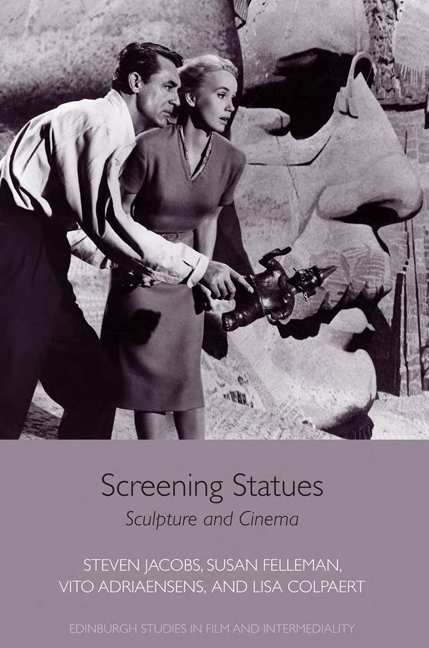Book contents
- Frontmatter
- Contents
- List of Figures
- Acknowledgements
- Introduction: The Marble Camera
- PART I
- 1 The Sculptor's Dream: Living Statues in Early Cinema
- 2 The Mystery … The Blood … The Age of Gold: Sculpture in Surrealist and Surreal Cinema
- 3 Carving Cameras on Thorvaldsen and Rodin: Mid-Twentieth- Century Documentaries on Sculpture
- 4 Anatomy of an Ovidian Cinema: Mysteries of the Wax Museum
- 5 The Night of the Human Body: Statues and Fantasy in Postwar American Cinema
- 6 From Pompeii to Marienbad: Classical Sculptures in Postwar European Modernist Cinema
- 7 Of Swords, Sandals, and Statues: The Myth of the Living Statue
- 8 Coda: Returning the Favor (A Short History of Film Becoming Sculpture)
- PART II
- Bibliography
- About the Authors
- Index
4 - Anatomy of an Ovidian Cinema: Mysteries of the Wax Museum
from PART I
Published online by Cambridge University Press: 23 June 2018
- Frontmatter
- Contents
- List of Figures
- Acknowledgements
- Introduction: The Marble Camera
- PART I
- 1 The Sculptor's Dream: Living Statues in Early Cinema
- 2 The Mystery … The Blood … The Age of Gold: Sculpture in Surrealist and Surreal Cinema
- 3 Carving Cameras on Thorvaldsen and Rodin: Mid-Twentieth- Century Documentaries on Sculpture
- 4 Anatomy of an Ovidian Cinema: Mysteries of the Wax Museum
- 5 The Night of the Human Body: Statues and Fantasy in Postwar American Cinema
- 6 From Pompeii to Marienbad: Classical Sculptures in Postwar European Modernist Cinema
- 7 Of Swords, Sandals, and Statues: The Myth of the Living Statue
- 8 Coda: Returning the Favor (A Short History of Film Becoming Sculpture)
- PART II
- Bibliography
- About the Authors
- Index
Summary
There's poetry in wax. From Pygmalion's ivory Galatea turning waxen to the touch, to the anatomical Venuses strewn erotically across the halls of La Specola in Florence, or wax mannequins melting slowly on celluloid, the haptic nature of the medium is intrinsically uncanny. Lifelike statues have been haunting our visual history for centuries, and as Kenneth Gross has aptly remarked, the idea of a statue coming to life could be bound to the opposing thought: that the statue was once something living. It is precisely this tension that lies at the heart of a number of films inspired by the wax museum and its mostly static inhabitants. This cultural phenomenon was made most famous by Madame Tussaud, who by the end of the eighteenth century had risen to fame crafting wax counterparts of notorious individuals. The wax creations’ semblance of life has unnerved visitors ever since, and cinema was quick to pick up on the mysteries of the wax museum, trying its best to transfer the magic of the medium to celluloid.
This chapter deals with the adaptation of the wax museum and its wax models to cinema, analyzing how the specificity of the medium and its visceral tropes have enjoyed a popular second life on the silver screen, in films such as Maurice Tourneur's eerie 1914 Figures de Cire, Michael Curtiz's canonical 1933 Mystery of the Wax Museum and Sergio Stivaletti's gore-filled giallo, M.D.C. – Maschera di cera (The Wax Mask, 1997). Featuring the recurrent character of the mad artist, these films play with the tensions between flesh and wax and turn death and sexuality into an inherent part of the sculptural process.
Shaping the Museum
The visceral qualities that wax possesses were not first ascribed to it by its incorporation in the horror genre, nor are they indebted solely to the efforts of Madame Tussaud; rather, they can be found in the organic material itself since it is secreted by plants and insects – most notably bees. Wax modeling was an ancient practice dating back as far as 3000 bc, but it only started to take on a more figurative shape in Florence between the thirteenth and sev¬enteenth centuries, when a true cult of votive offerings created an industry in wax.
- Type
- Chapter
- Information
- Screening StatuesSculpture and Cinema, pp. 84 - 100Publisher: Edinburgh University PressPrint publication year: 2017



